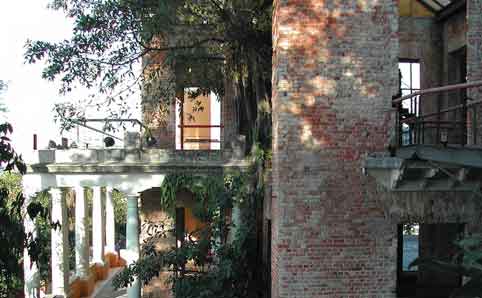
While the majority of Rio’s new arrivals will head straight to the golden sands of Ipanema and Copacabana, Santa Teresa has become a rival for the more adventurous tourists’ affections over the past few years. Cobbled streets, idiosyncratic architecture and its remote hillside location make Santa an enchanting diversion from the high-rise apartments of Zona Sul.
Eating and drinking
 Culinarily speaking, Santa Teresa is crammed with restaurants making the most of the scenic setting. Those feeling flush shouldn’t miss the opportunity to check out the view from Térèze, the sublimely romantic bar and restaurant in Hotel Santa Teresa but a “treehouse” booth in nearby Aprazível with its views of Centro and beyond, makes for a memorable meal too. Hearty dishes to suit more modest budgets can be found at Simplesmente or Bar do Arnaudo, both close to Largo do Guimarães, while seafood lovers are in for a treat at both Sobrenatural and Amazonian specialist Espirito Santa (pictured) a little further down the track.
Culinarily speaking, Santa Teresa is crammed with restaurants making the most of the scenic setting. Those feeling flush shouldn’t miss the opportunity to check out the view from Térèze, the sublimely romantic bar and restaurant in Hotel Santa Teresa but a “treehouse” booth in nearby Aprazível with its views of Centro and beyond, makes for a memorable meal too. Hearty dishes to suit more modest budgets can be found at Simplesmente or Bar do Arnaudo, both close to Largo do Guimarães, while seafood lovers are in for a treat at both Sobrenatural and Amazonian specialist Espirito Santa (pictured) a little further down the track.
When the sun goes down the hillside springs to life again and the bohemian residents of Santa line the streets outside the numerous bars for a bate-papo (chat). Join them for a shot of artesanal cachaça at time-honoured Bar do Gomez, or admire the art on the walls of Bar do Mineiro while sipping an ice-cold beer. German-themed Mike’s Haus may not attract the same size of crowds, but the towering, juicy house Mike’s Burger is the perfect late-night filler to round off the day.
Around town
 The best way to explore Santa Teresa is simply on foot, even if the cobbles do take their toll after a few hours. Start at Largo do Curvelo and drink in the sweeping view of Guanabara Bay before taking the short walk to Parque das Ruínas (pictured). This once-grand mansion fell into ruin after the death of its owner in 1946, and its innovative glass-and-ironwork restoration uses the shell of what was left in a striking fusion of the old and the new. As well as having a spectacular view of its own, Parque das Ruínas sits alongside Museu da Chácara do Céu, the neighbourhood's principal art museum that includes works by Miró and Matisse and was the site of a famous robbery in 2006 when, during Carnival, works by Dali and Picasso were among those taken.
The best way to explore Santa Teresa is simply on foot, even if the cobbles do take their toll after a few hours. Start at Largo do Curvelo and drink in the sweeping view of Guanabara Bay before taking the short walk to Parque das Ruínas (pictured). This once-grand mansion fell into ruin after the death of its owner in 1946, and its innovative glass-and-ironwork restoration uses the shell of what was left in a striking fusion of the old and the new. As well as having a spectacular view of its own, Parque das Ruínas sits alongside Museu da Chácara do Céu, the neighbourhood's principal art museum that includes works by Miró and Matisse and was the site of a famous robbery in 2006 when, during Carnival, works by Dali and Picasso were among those taken.
Largo do Guimarães is the closest thing this neighbourhood has to a centre. The flocks of tourists have precipitated a crop of stores and street stalls here flogging as much ten-a-penny jewellery as original artefacts you might actually want to take home with you, so a safer bet for art lovers is to ring ahead and make an appointment at one of the many studios such as the unusual Ateliê Pedro Grapiuna. Also worth a visit, the CasAlegre Art Vila, is one of the few spaces in Santa to host exhibitions, with guests and public alike treated to works of art from a new artist every month. The pousada also offers cooking courses, massage and yoga as well as the exhibition space in a beautiful old house.
There are many winding routes down from Santa to ground level. Some are safer than others, but a daylight wander down Rua Monte Alegre offers up the incongruous sight of the Russian orthodox church, Santa Zenaide (Rua Monte Alegre 210, 2252 1471), with it's iconic golden dome. Further up the same road is the Centro Cultural Laurinda Santos Lobo (Rua Monte Alegre 306, 2242 9741), which has a rather haphazard selection of cultural events showing, from photographic exhibitions to yoga weekends.
The white Castelo Valentim is another striking curio, and at almost the highest point of Rua Almirante Alexandro is visible even from some parts of Centro. The fairytale castle, now divided into flats, was commissioned by a Belgian immigrant at the beginning of the last century and left to his architect when he died. It is not open to visitors but makes for some dramatic photos with its rich green backdrop of the forest. SImilarly stand-out from afar is the old Convento Santa Teresa (Ladeira Santa Teresa 52,
Events
Santa Teresa is synonymous with bohemian living, and the largely arty population opens its studio doors to the public once a year for a weekend of festivities known as Arte de Portas Abertas (Open Door Art). Usually held around June or July, expect impromptu jazz in the streets and a feast of exhibitions all day (and night) long.
Getting there
Santa Teresa may be beautiful, but it's also a bit of a pain to get to. Until August 2011, jumping aboard the rickety yellow trams to get to this secluded spot was a staple on the tourist agenda, but following a tragic accident in which six people died, all the trams have been taken off the road for major repairs. Your best bet is either to take the 006 or 014 bus from Centro, or see if you can persuade a taxi driver to make the climb.



